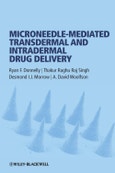Microneedle-mediated Transdermal and Intradermal Drug Delivery covers the major aspects relating to the use of microneedle arrays in enhancing drug delivery applications. It provides an overview of the various methods employed to design and produce microneedles, from the different materials involved to the importance of application methods. It carefully and critically reviews ongoing transdermal and intradermal delivery research using microneedles and includes the outcomes of in vivo animal and human studies. Importantly, it also discusses the safety and patient acceptability studies carried out to date. Finally, the book reviews the recent patents in microneedle research and describes the ongoing developments within industry that will determine the future of microneedle-mediated transdermal and intradermal drug delivery.
By an expert author team with practical experience in the design and development of drug delivery systems this is the only text that provides a comprehensive review of microneedle research in transdermal and intradermal drug delivery.
Table of Contents
Preface, ixAbout the Authors, xiii
1 Transdermal Drug Delivery, 1
1.1 Genesis of transdermal drug delivery, 1
1.2 Skin anatomy, 2
1.2.1 The epidermis, 2
1.2.2 The stratum corneum, 4
1.2.3 The dermis, 6
1.2.4 Skin appendages, 6
1.3 Routes to percutaneous drug absorption, 7
1.4 Facilitated transdermal drug delivery, 11
1.4.1 Cryopneumatic and photopneumatic technologies, 12
1.4.2 Sonophoresis (low-frequency ultrasound), 12
1.4.3 Iontophoresis, 13
1.4.4 Electroporation, 14
1.4.5 Jet injection, 14
1.4.6 Microneedles, 15
References, 15
2 Microneedles: Design, Microfabrication and Optimization, 20
2.1 Introduction, 20
2.2 Methods of fabricating microneedles, 21
2.2.1 Microfabrication of silicon microneedles, 22
2.2.2 Microfabrication of metal and other types of MNs, 31
2.2.3 Microfabrication of polymeric microneedles, 34
2.3 Optimization to MN design for transdermal drug delivery, 46
2.4 Conclusion, 49
References, 51
3 Microneedle Applicator Designs for Transdermal Drug Delivery Applications, 57
3.1 Introduction, 57
3.2 Considerations of microneedle applicators designs, 72
3.3 Conclusion, 76
References, 76
4 Transdermal Delivery Applications, 79
4.1 Introduction, 79
4.2 Transdermal drug delivery, 79
4.2.1 Partition co-efficient between 1 and 3, 80
4.2.2 A relatively low melting point, 80
4.2.3 A molecular weight less than 500 Da, 81
4.2.4 Unionized, 81
4.3 Modulation of transdermal penetration using microneedles, 82
4.4 Transdermal delivery using solid microneedles, 83
4.4.1 Transdermal delivery of low molecular weight compounds (RMM < 600 Da) in vitro using solid microneedles, 84
4.4.2 Transdermal delivery of low molecular weight compounds (RMM < 600 Da) in vivo using solid microneedles, 86
4.4.3 Transdermal delivery of high molecular weight compounds (RMM > 600 Da) in vitro using solid microneedles, 88
4.4.4 Transdermal delivery of high molecular weight compounds (RMM > 600 Da) in vivo using solid microneedles, 89
4.5 Transdermal delivery using hollow microneedles, 91
4.5.1 Transdermal delivery of low molecular weight compounds (RMM < 600 Da) in vitro using hollow microneedles, 91
4.5.2 Transdermal delivery of low molecular weight compounds (RMM < 600 Da) in vivo using hollow microneedles, 92
4.5.3 Transdermal delivery of high molecular weight compounds (RMM > 600 Da) in vitro using hollow microneedles, 93
4.5.4 Transdermal delivery of high molecular weight compounds (RMM > 600 Da) in vivo using hollow microneedles, 93
4.6 Transdermal delivery using biodegradable microneedles, 96
4.6.1 Transdermal delivery of low molecular weight compounds in vitro using biodegradable MN, 96
4.6.2 Transdermal delivery of low molecular weight compounds in vivo using biodegradable MN, 98
4.6.3 Transdermal delivery of high molecular weight
compounds in vitro using biodegradable MN, 98
4.6.4 Transdermal delivery of high molecular weight compounds in vivo using biodegradable MN, 100
4.7 Microneedles in combination with other enhancement strategies, 102
4.8 Conclusion, 105
References, 107
5 Microneedle-mediated Intradermal Delivery, 113
5.1 Introduction, 113
5.2 Vaccine delivery, 113
5.2.1 Vaccination, 113
5.3 Intradermal vaccination, 116
5.3.1 Skin structure, 117
5.3.2 Skin immune response, 117
5.3.3 Conventional strategies for intradermal vaccine delivery, 118
5.3.4 Coated microneedles, 120
5.3.5 ‘Poke and Patch’ approaches, 129
5.3.6 Hollow microneedles, 131
5.3.7 Dissolving/biodegrading polymeric microneedles, 133
5.3.8 Epidermal gene delivery, 135
5.4 Intradermal delivery of photosensitizers for photodynamic therapy, 139
5.4.1 Microneedle-mediated intradermal delivery of 5-aminolevulinic acid and derivatives, 141
5.4.2 Microneedle-mediated intradermal delivery of preformed photosensitizers, 143
5.5 Intradermal delivery of nanoparticles, 144
5.6 Conclusion, 146
References, 147
6 Clinical Application and Safety Studies of Microneedles, 152
6.1 Introduction, 152
6.2 Clinical and safety consideration for MN application, 153
6.2.1 Sensation of pain, 153
6.2.2 Recovery of micropores and possibility of infection following microneedle application, 155
6.2.3 Erythema, 156
6.2.4 Biocompatability and biodegradation of MN material, 157
6.3 Conclusion, 159
References, 160
7 Microneedles: Current Status and Future Perspectives, 164
7.1 Introduction, 164
7.2 Biological fluid sampling devices, 167
7.3 Ocular drug delivery, 172
7.4 Cosmetic applications, 175
7.5 Industrial perspectives, 177
7.6 Hydrogel-forming microneedle arrays, 179
7.7 Moving forwards, 181
7.8 Conclusion, 184
References, 185
Index, 188








